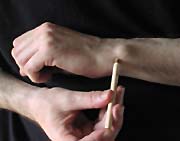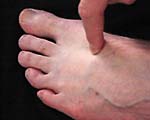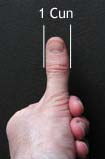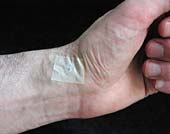How to apply acupressure
Acupressure techniques, what they do, how to apply them, and how you feel the effects.
- Acupressure techniques: Pressing and reducing points
- Feeling if it works
- Using information from other sources ("cun")
- What manipulation of points brings about
- Why you shouldn't use needles
- Using little balls and tape
What is acupressure?
Acupressure (sometimes written as "accupressure") is a technique related to acupuncture, where the energies of the body are regulated by manipulating points on the body. This has effects on the emotions, tension and physical conditions.
The points are commonly called "acupuncture points," "pressure points," "acupoints" or "acupressure points."
Acupressure techniques: Pressing and reducing points
There are two ways that acupressure points are manipulated: pressing (reinforcing) and reducing them. Most are probably familiar with the first, but not with the second method.
 To press points, use something blunt. Usually the fingers are used to press, but I find that for many points the fingers may be a bit too thick, so you'd have to press quite long and firmly. Ideal would be something 3 to 4 mm thick, like a (preferably used) pencil eraser that's on the other side of a pencil. Some points can be pressed using a fingernail.
To press points, use something blunt. Usually the fingers are used to press, but I find that for many points the fingers may be a bit too thick, so you'd have to press quite long and firmly. Ideal would be something 3 to 4 mm thick, like a (preferably used) pencil eraser that's on the other side of a pencil. Some points can be pressed using a fingernail.
Pressing points for less than half a second can already have a distinguishable effect. So for just trying out a point you could press it only briefly. To get a full effect however, pressure should be applied for at least half a minute, but preferably longer. One to two minutes should do.
 To reduce a point, turn a finger over it in counter-clockwise direction, also for one to two minutes. (What happens when you do this is explained in "What manipulation of points brings about.") Clicking on the picture of points that need to be reduced displays a video showing how this is performed (clicking again stops the video).
To reduce a point, turn a finger over it in counter-clockwise direction, also for one to two minutes. (What happens when you do this is explained in "What manipulation of points brings about.") Clicking on the picture of points that need to be reduced displays a video showing how this is performed (clicking again stops the video).
I think it's a good idea not to get into the habit of doing the same points every day. Do them when you feel you need them, don't overdo it. Pay attention to what effects points have on you.
If you're weakened (from age, disease or whatever), be sure to not reduce points more often then necessary. You could also additionally press these points for a few seconds.
Do a point on both sides of the body.
Feeling if it works
When you are not feeling any effects from pressing points, several things may be the case.
You may not be pressing on the exact right spot (acupuncture points are about 0.5 mm diameter, so you'll have to be precise). Try different spots around the location you first tried.
You shouldn't press lightly, but you shouldn't hurt yourself either. Also, don't press for just a few seconds (although if you're very sensitive you might already notice effects then).
To feel if acupressure is working (for knowing that the location of the point is accurate), I usually sense what's happening in my face. Almost all points in the list on this site have some effect here. Many of the points also have some subtle effect on the quality of vision. You may see more clearly and more colors. Meditation will develop your ability to feel the effects.
If you're using a point quite often, or if you don't need a point, the effect may become very little or unnoticeable.
If you're tense, you may not feel much, although usually you'll become less tense by using the techniques on this site.
Using information from other sources ("cun")
To be able to use information from other sources for locating points, you'll need to know what the "cun" is.
 The "cun" is the standard unit of measurement for the body used in acupuncture. As everyone's body has different dimensions, it is defined according to the person whose body is to be treated.
The "cun" is the standard unit of measurement for the body used in acupuncture. As everyone's body has different dimensions, it is defined according to the person whose body is to be treated.
1 cun = width of the thumb, in the middle, at the crease
3 cun = combined breadth of the 4 fingers, at the level of the pinky finger's first joint above the palm of the hand
12 cun = the distance from the elbow crease to the wrist
crease.
What manipulation of points brings about
Acupuncture points can be manipulated in various ways. To keep things simple, acupressure books usually just mention pressing the points.
If you've ever seen an acupuncturist you may have noticed that he will turn needles after inserting them or do other manipulations. Acupuncturists also apply heat by burning stuff called "moxa" or using a laser, or apply electric currents.
By simply pressing a point, you are reinforcing it. You, thereby, increase energy in areas that the point influences. Reducing a point is actually not the opposite of reinforcing it. By reducing, you remove a blockage of energy. A blockage may be felt as tension, pain or heat. Energy accumulates there, which starts moving again after removing the blockage. So if you reduce a point after you reinforced it, you get reinforcement and removal of energy blockage. They don't cancel each other out.
In acupressure, you can reduce a point by continually moving a finger counterclockwise over it. An acupuncturist will turn his needle immediately after insertion.
It's also possible to apply heat to a point to warm it. This is an advanced technique that may injure your energy system, so it's best to stay away from this.
Why you shouldn't use needles
As for using needles, I've tried that, but have been discouraged to continue using them by both an acupuncturist and a healer. The acupuncturist thought it was dangerous because you can damage tissue, and difficult as you can't access points that well yourself. You may damage blood vessels, nerves, tendons or bone, which can all be quite painful. On the breast or shoulders, you may puncture the lung.
On an energetic level, the fear that comes with using needles on yourself may damage the First Chakra. This may worsen your problems.
Using needles as an amateur may not even be legal.
I found that I feel more clearly what's happening in my body from acupressure than from acupuncture, whether administered by a licensed acupuncturist or by myself.
Using little balls and tape
I devised a safe and effective way to press acupuncture points for an extended period of time. I use adhesive tape for use on skin to press ball-bearing balls on points. It doesn't work with all points (e.g. it does not work well for ST-36, the point beneath the knees) but for many it's quite good.
 The metal balls I use are 4 mm diameter and I apply nylon rings (also bought at a hardware store) on top of them to supply a larger surface to the tape. The inside diameter of the nylon rings should be 3 mm. Perhaps you could also use the more common metal rings, but for some indefinite reason I prefer the nylon variety. The rings avoid bulging and thus press the ball a bit deeper into the skin.
The metal balls I use are 4 mm diameter and I apply nylon rings (also bought at a hardware store) on top of them to supply a larger surface to the tape. The inside diameter of the nylon rings should be 3 mm. Perhaps you could also use the more common metal rings, but for some indefinite reason I prefer the nylon variety. The rings avoid bulging and thus press the ball a bit deeper into the skin.
Keeping the balls in place for 5 - 30 minutes should do.
A similar method is sometimes used for ear acupuncture. Little seeds are then taped to the ear.


